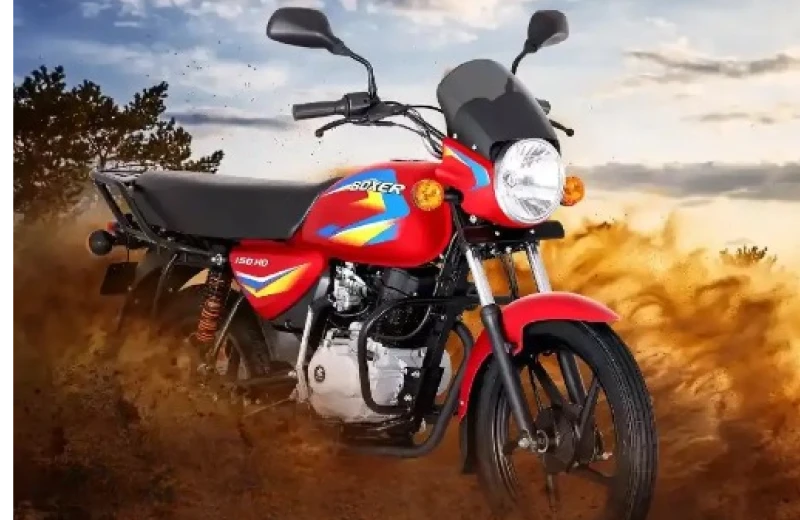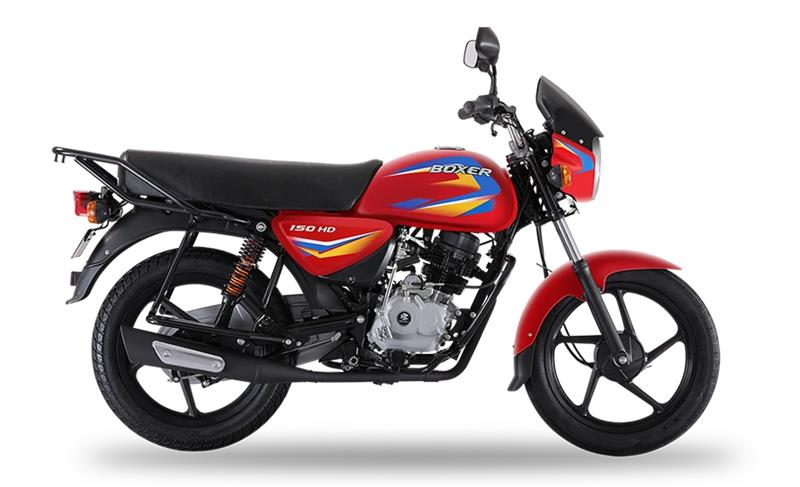
Choose your Country

Choose your Country

Riding a motorcycle across rural Kenya is no easy task. Deep potholes, heavy dust, and flooded tracks strain both rider and machine every day. A short trip between towns like Kiminini and Kitale can quickly become a challenging test of endurance. When your income depends on your bike, even a minor breakdown can mean losing a full day’s earnings.
To tackle such challenges, the Bajaj Boxer 150 HD stands as a popular choice, particularly for its ability to thrive in tough conditions. Its strong frame, high ground clearance, and fuel-saving design make it a familiar sight in Nairobi, Meru, Kisumu, and Eldoret. However, even the most durable bikes need proper care to endure harsh roads.
Simple habits, such as checking the oil, inspecting the tyres, and tightening loose bolts, can prevent significant problems. A few minutes of maintenance each morning help keep your bike running smoothly, your business moving forward, and your daily goals within reach.
Let’s explore some simple maintenance tips to keep your ride solid for the long run!
Prepare for every road ahead.
Browse Bajaj Boxer bikes built for real-world conditions.
Keeping your Boxer 150 HD reliable on rural roads depends on regular care across all bike parts. Grouping maintenance tasks by system can help you stay on top of the work without missing any important details.
Low oil levels can lead to engine overheating, especially during long, uphill rides. Use the dipstick before the engine warms up. If the oil appears dirty or thin, top it up or plan a change within the week.
Dirty oil loses its ability to protect engine parts. Riders using rough, dusty roads should replace oil even earlier if the engine runs hotter. Oils like Total Quartz 20w-50 handle Kenyan temperatures well.
Dust buildup restricts airflow, straining the engine. After rides through dry, dusty areas like Isiolo or Lodwar, remove the air filter and clean it by tapping or blowing off dust.
Dust and mud dry out the chain fast, especially in rural tracks after rain. Apply chain oil while slowly rotating the rear wheel. A dry chain can damage sprockets and increase fuel consumption.
A loose clutch leads to rough gear changes and strains the gearbox. Check that the clutch play at the lever stays between 2–3 mm. Like in Meru, riders climbing steep roads with heavy loads should be inspected more frequently.
Squeeze the front and rear brake levers before riding out. Soft or delayed braking points on worn shoes are dangerous on downhill village roads and slippery surfaces.
Open the drum housings if possible or listen for grinding sounds when braking. Heavy braking on steep terrain wears down shoes faster.
Deflated tyres cause poor handling and faster wear. Use a manual check or pressure gauge. Inspect the treads for cuts, nails, or signs of heavy wear every week. A damaged tyre can collapse suddenly on rocky tracks.
Visibility is critical for early morning and late evening rides. Switch all lights on before departure. Replace any faulty bulbs immediately.
Loose or corroded terminals reduce charging and weaken the starter system. Clean any corrosion with a brush and tighten connections firmly.
Ensure the headlamp brightness stays consistent. Flickering lights often signal battery issues or wiring faults that need repair before they worsen.
Bumpy rural roads loosen engine mount bolts, luggage racks, and footrests. Use a spanner to check tightness before problems appear.
Oil smears near the front forks or weak bouncing on the rear indicate suspension wear. A faulty suspension affects handling badly on rough roads.
After parking overnight, check under the bike for any leaks of oil, fuel, or brake fluid. Even small leaks can proliferate, leading to expensive repairs or loss of braking.
Be the rider who keeps a simple, consistent routine across these five systems, and avoid the costly cycle of breakdowns, lost rides, and emergency repairs. In the harsh conditions of rural Kenya, maintenance is not an extra task. It is part of staying in business.

Riding across rural roads of Kenya demands a bike you can trust. And the Boxer 150 HD is specifically designed for that purpose. Its 144.8 cc, 4-stroke, natural air-cooled engine delivers 12 PS of power at 7500 rpm and 12.55 Nm of torque — a strength that helps you climb hills, carry heavy loads, and travel long distances without overexertion.
The 125 kg frame, with 125 mm front and 100 mm rear suspension travel, cushions rough paths and potholes. Whereas, an 11-litre fuel tank, a 12v full DC electrical system, and a 4Ah VRLA battery ensure you’re unstoppable!
When you depend on your bike to earn a living, you need a machine that stays ready. Thankfully, the power of Bajaj and routine maintenance can help you stay on the road uninterrupted! Contact us today to bring home your own Bajaj Boxer!
1. How often should the Boxer 150 HD be serviced?
Bajaj recommends a regular servicing schedule every 5,000 km to ensure optimal performance for the bike.
2. Which engine oil is suitable for the Boxer 150 HD in rural areas?
Oils with a 20w-50 rating, such as Total Quartz, are commonly used in high-temperature regions like Kenya.
3. Is it advisable to use local mechanics for maintenance?
Trained local mechanics may be a practical option for routine checks and minor repairs. For complex issues, visiting an authorised service centre is recommended.
4. What are the early signs that maintenance may be required?
Changes such as reduced braking efficiency, unusual engine noise, fluid leaks, or handling instability can indicate the need for inspection.
One Bike, Many Jobs: How Boxer Supports Everything from Boda Boda to Agro-Deliveries
Know More
Powering Small Businesses: How Tuktuks are Driving Entrepreneurship in Nairobi and Western Kenya
Know More
The Backbone of the Rift Valley: How Motorcycles Empower Rural Kenya
Know More
5 Common Mistakes That Shorten Your Boxer’s Lifespan (And How to Avoid Them)
Know More
How the 5-Speed Gearbox Gives Boxer Riders a Real Edge in Kenya
Know More
From Shock Absorption to Frame Strength: A Deep Dive into Boxer 150 X’s Tough Build
Know More
Discovering the Significance of Three-Wheeler Tuk-tuks for Urban Accessibility in Kenya
Know More
Heavy-Duty Power for Heavy-Duty Tasks: Why the Bajaj Boxer 150 HD is a Game-Changer
Know More
How Bajaj Bikes Drive Economic Development in Kenya
Know More
Why Small Business Owners Trust the Boxer 125 HD
Know More
Maintaining Your Tuk-tuk in Kenya: Essential Tips for Longevity and Efficiency Across Regions
Know More
From 100cc to 150cc: How to Choose the Best Bajaj Boxer Range for You?
Know More
Why Tuktuks Are the Smartest Way to Deliver in Kenya’s Towns
Know More
Power That Pays Off: Why the Boxer 125 HD Is Your True Income Enabler
Know More
Understanding How the Bajaj Boxer Masters Challenging Conditions
Know More
Bajaj Boxer 100 HD ES: The Flexible Performer for Everyday Business
Know More
Mastering Your Bajaj Boxer: A Rider’s Guide to Enhanced Performance
Know More
Boxer HD Series Breakdown: Which Model Fits Your Hustle?
Know More
The Tuktuk Experience: Why Tuktuks Are Kenya’s Smartest Urban Transport Tool
Know More
The Only Bike You’ll Ever Need: How Bajaj Boxer Adapts to Any Job in Kenya
Know More
Boxer 100cc Series: The Smart Pick for Reliable, Everyday Power
Know More
Why the Boxer 125 Is the Smartest Bike for Kenya’s Boda Boda Business
Know More
Ride Rough, Stay Steady: Boxer’s Suspension System Explained
Know More
Mastering the Metropolis: Selecting the Right Motorbike for Urban Utilities
Know More
The Bajaj 150 X: The Perfect Load Carrier for Rough Roads and Long Rides
Know More
From Thika Roads to Maasai Mara Trails: Bajaj Motorcycles, Kenya's Reliable Workhorse
Know More
The Social Impact of Motorcycles in Western Kenya's Communities
Know More
Navigating Nairobi's Urban Pulse: Why Bajaj Motorcycles Are the City Rider's Choice
Know More
Why Every Delivery Rider in Town Should Be Eyeing the Boxer 125 HD
Know More
Buying a Motorcycle in Nairobi? Your Guide to Making a Smart Selection
Know More
Why the Bajaj Boxer Motorcycle is the Undisputed King of Tough Terrains
Know More
From Nairobi's Hustle to Rural Paths: The Bajaj Boxer, Kenya's Unsung Hero
Know More
Powering the Rift Valley: Why the Boxer 150cc is the Go-To for Kenyan Farmers and Traders
Know More
Which Bajaj Motorcycle is Right for Your Business in Kenya? A Comprehensive Buyer's Guide
Know More
Bajaj Three-Wheelers in Kenya: Driving Business Growth and Mobility
Know More
Bajaj vs. Competitors: Why Bajaj Dominates the Kenyan Motorcycle Market
Know More
Fuel Efficiency and Durability: The Bajaj Advantage for Kenyan Riders
Know More
Maximising Your Boxer 150's Performance and Longevity: Essential Tips
Know More
Bajaj Boxer 125 vs. Competitors: A Head-to-Head Battle for the 125cc Crown
Know More
Second-Hand vs. Brand New Bikes in Kenya: Which One Should You Buy?
Know More
A Deep Dive into the Bajaj Boxer 100 HD ES Comfort Features
Know More
Why Every Smart Driver is Upgrading to the New Bajaj RE 4S Petrol
Know More
Built to Outlast the Daily Hustle: The New RE’s Frame, Finish, and Features
Know More
Ride-Hailing at Scale? Here’s Why the RE 4S is the Backbone You Need
Know More
5 Reasons Ride-Hailing Fleets Should Switch to the New Bajaj RE 4S
Know More
5 Reasons Why Boxer Is the Best Mototaxi Bike in Kenya
Know More
What’s the Ideal Boxer Model for You? A Buyer’s Guide
Know More
A Beginner’s Guide to Boxer Motorcycle Servicing
Know More
Your First Bike? Here’s Why Boxer Is the Right Choice
Know More
Types of Motorbikes in Kenya: A Complete Guide for Buyers
Know More
How to Maintain Your Boxer Motorbike for Long-Term Use
Know More
The Economic Impact of Boxer Bikes on Village Mobility
Know More
What Makes Boxer Bikes Ideal for Agricultural Transport?
Know More
Boxer 100 Series: The Best Motorcycles for Light Commercial Use
Know More
Best Boxer Bike in Kenya for Rural Transport in 2025
Know More
Exploring the Durability of Boxer Bikes on Kenyan Roads
Know More
How Boxer Bikes Help Small Business Owners in Kenya
Know More
Why Boxer 100 HD Is the Most Fuel-Efficient Utility Bike
Know More
Why Boxer 100 HD ES Is Perfect for City and Village Use
Know More
Boxer 100 HD ES: Durability, Comfort, and Performance Combined
Know More
Maintenance Tips to Keep Your Bajaj Boxer 125 HD Running Strong
Know More
Why Mototaxi Drivers Prefer Boxer 100 KS
Know More
Choosing Between Boxer 100 KS and Boxer 100 HD: A Practical Guide
Know More
Same Spirit, Two Styles: Exploring the Boxer 100 KS and HD ES
Know More
The Boxer 100 KS: Affordable Mobility for First-Time Buyers
Know More
The Boxer 125 X: A Flexible Workhorse for All Terrains
Know More
How the Boxer 125 X Offers Flexibility for Small Businesses
Know More
How Boxer 150 HD Handles Load Like a Pro
Know More
Why the Boxer 150 HD Is a Status Symbol in Transport Circles
Know More
How Boxer 150 X Helps Mototaxi Operators Maximise Earnings
Know More
Top Features That Define the Boxer Motorcycle
Know More
The Champion of Rough Roads: Boxer 150 X Review
Know More
Why the Boxer 150 X Dominates Africa’s Toughest Terrains
Know More
How Boxer Bikes Are Powering Kenya’s Economy
Know More
Getting to Know the Heavy Duty Boxer 150cc Range: Features and Benefits
Know More
Bajaj Boxer for Heavy-Duty Tasks: Rugged, Reliable, and Ready to Roll
Know More
Boxer 150 HD: Built Tough for Long Routes and Heavy Loads
Know More
Value Meets Reliability: Why Bajaj Bikes Are Perfect for Kenyan Roads
Know More
5 Reasons the Boxer 150 X Is Built for Boda Boda
Know More